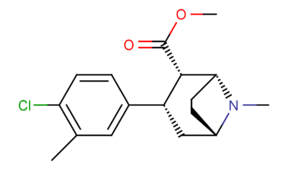RTI-112
 | |
| Identifiers | |
|---|---|
| |
| CAS Number |
143982-09-6 HCl: 150653-92-2 |
| PubChem (CID) | 9972515 |
| ChemSpider |
8148107 |
| ChEMBL |
CHEMBL1812745 |
| Chemical and physical data | |
| Formula | C17H22ClNO2 |
| Molar mass | 307.82 g/mol |
| 3D model (Jmol) | Interactive image |
| |
| |
| | |
RTI(-4229)-112 (2β-carbomethoxy-3β-(3-methyl-4-chlorophenyl)tropane) is a synthetic stimulant drug from the phenyltropane family. In contrast to RTI-113, which is DAT selective, RTI-112 is a nonselective triple reuptake inhibitor.[1]
In vitro tests show a very similar serotonin transporter (SERT)/dopamine transporter (DAT)/norepinephrine transporter (NET) selectivity to cocaine,[2] although in vivo behaviour is different:
"The nonselective monoamine transporter inhibitor RTI-126 and the DAT-selective inhibitors RTI-150 and RTI-336 both had a faster rate of onset (30 min) and a short duration of action (4h). In contrast, the nonselective monoamine transporter inhibitor RTI-112 had a slower rate of onset (30–60 min) and a longer duration of action (10h). The DAT-selective inhibitors RTI-171 and RTI-177 also had slower rates of onset (30–120 min), but RTI-171 had a short duration of action (2.5 h) while RTI-177 had a very long duration of action (20 h)."[3]
The efficacy of cocaine analogs to elicit self-administration is related to the rate at which they are administered. Slower onset analogs are less likely to function as behavioral stimulants than analogs eliciting a faster rate of onset.[4] Nonselective analogs are less likely to function as "reinforcers" than reuptake inhibitors that have DAT specificity.[3]
In order for a dopamine reuptake inhibitor (DRI) such as cocaine to induce euphoria, PET scans on primates reveal that the DAT occupancy needs to be >60%.[5]
RTI-112 has equipotent in vitro affinity at the SERT, NET and DAT, respectively.[2] RTI-112 was not reliably self-administered, in contrast to the DAT selective reuptake inhibitors that were used in this study.[2] In vivo at the ED50, RTI-112 had no DAT occupancy at all.[2] At the ED50, almost all of the RTI-112 occupied the SERT at this dose.[2] A significantly higher dose was required to get >70% DAT occupancy in the case of RTI-112;[2] however, RTI-112 was still able to suppress cocaine administration at the ED50, suggesting a serotonergic mechanism was responsible for this.[2]
References
- ↑ Ginsburg, B.C., Kimmel, H.L., Carroll, F.I., Goodman, M.M., Howell, L.L. Interaction of cocaine and dopamine transporter inhibitors on behavior and neurochemistry in monkeys. Pharmacology Biochemistry and Behavior, 80: 481-491, 2005.
- 1 2 3 4 5 6 7 Lindsey, K.P., Wilcox, K.M., Votaw, J.R., Goodman, M.M., Plisson, C., Carroll, F.I., Rice, K.C., Howell, L.L. (2004) "Effects of dopamine transporter inhibitors on cocaine self-administration in rhesus monkeys: relationship to transporter occupancy determined by positron emission tomography neuroimaging." Journal of Pharmacology and Experimental Therapeutics, 309: 959-969
- 1 2 Kimmel, HL; O'Connor, JA; Carroll, FI; Howell, LL. (Jan 2007). "Faster onset and dopamine transporter selectivity predict stimulant and reinforcing effects of cocaine analogs in squirrel monkeys". Pharmacol Biochem Behav. 86 (1): 45–54. doi:10.1016/j.pbb.2006.12.006. PMC 1850383
 . PMID 17258302.
. PMID 17258302. - ↑ Wee S, Carroll FI, Woolverton WL (2006). "A Reduced Rate of In Vivo Dopamine Transporter Binding is Associated with Lower Relative Reinforcing Efficacy of Stimulants". Neuropsychopharmacology. 31 (2): 351–362. doi:10.1038/sj.npp.1300795. PMID 15957006.
- ↑ Howell, L.L. and Wilcox, K.M. "The dopamine transporter and cocaine medication development: Drug self-administration in nonhuman primates." Journal of Pharmacology and Experimental Therapeutics, 298: 1-6, 2001.